Next Level Astrology: How to Use Synastry and Aspect Patterns for Compatibility
Date 8/29/2025
Explore More:
Astrology
You may have seen articles exploring the compatibility of people with different sun signs, but comparing sun signs isn’t the only way to tell if a relationship will be harmonious. To get advanced astrological compatibility insights, you’ll need to take a look at synastry. Synastry is the method of astrology used to analyze relationships and explore the compatibility of people. It can be used to get insight into a variety of relationships - romantic, friendly, professional, family, etc.
When doing synastry analysis for relationships, you can gain insight into what is and isn’t compatible between two people and learn if the dynamics are beneficial for either in the long run. Synastry astrology is used to determine birth chart compatibility. To begin the process, the natal birth charts of two people are laid on top of each other and the aspect patterns, or angles between the planets are examined to deduce compatible and incompatible facets in the relationship. These angles are referred to as “aspects” in astrology, and we use 5 major aspects when examining an astrological chart.
Understanding Five Major Aspect Patterns
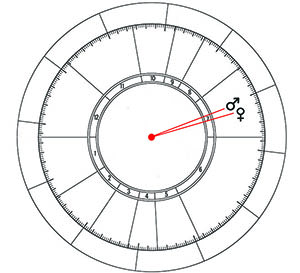
Conjunction
A conjunction aspect arises when two planets appear to be next to each other in the chart, typically within 8 degrees of each other. A conjunction boosts and strengthens the intensity of these two planets and the energies they symbolize, which can either be empowering for both or disempowering for one if their energy is swallowed up by the intensity of the other person/planet. A conjunction is an amplification, for better or for worse.
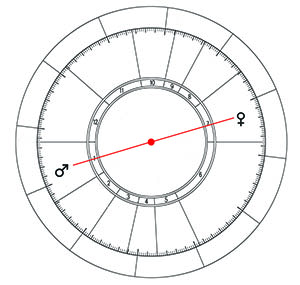
Opposition
An opposition aspect is when two planets are directly across the chart from each other, roughly 180 degrees apart, and considered to be opposing each other. This can be considered a butting of heads, a contrast, or a stark difference. An opposition is often a struggle to balance the energy between two extremes and can manifest as two people being fundamentally different or not seeing eye to eye. Sometimes opposites attract and some differences and challenges in a relationship can be beneficial for growth and excitement, but too many opposition aspects might make a relationship too difficult to be worth the struggle.
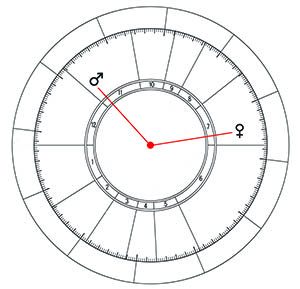
Trine
A trine aspect is when two planets are 120 degrees apart from each other in a chart. Because they are regarded as a very harmonious aspect to have in a relationship, the more trines the merrier. Trines are considered to be very productive, lucky, and have positive energy. They are associated with good vibes and lots of potential for happiness and growth. Occasionally, 3 trine aspects in a chart can form a full triangle, which is considered to be very significant, often rare, and a good sign of divine purpose in the relationship being reviewed.
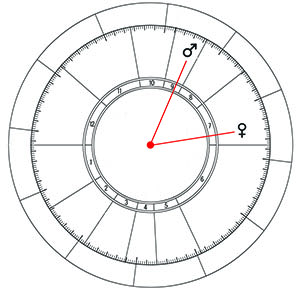
Sextile
A sextile aspect is when two planets are 60 degrees apart in a synastry chart. This is another very harmonious, kind, friendly, and complementary angle. Lots of sextile aspects in a synastry chart would indicate an easy-flowing relationship, with a lot in common, similar mindsets and ideologies, and compatible lifestyles. A sextile aspect indicates the areas in life where two people flow very easily together and bump heads very little. It’s an easy, breezy, happy aspect.
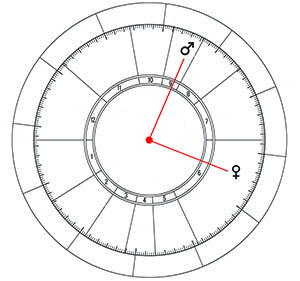
Square
A square aspect is when two planets are 90 degrees apart in a synastry chart. It is often a very challenging aspect in a relationship. Considered a very unproductive aspect, a square could generate a lot of arguing and frustration and make a part of the relationship very difficult. This could manifest as one person in the relationship being very controlling and not accepting the other person as they are, or just generally not seeing eye to eye or agreeing on certain topics.
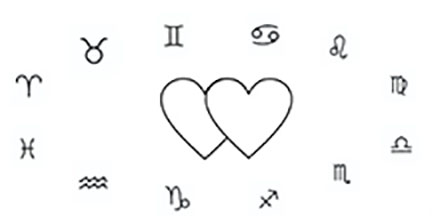
Aspects in a Synastry Chart and Compatibility
Something important to note is that there are often dozens of aspects in a single synastry chart. A relationship could have many compatible aspects, but just a few difficult aspects in very important topics could be enough of a difference to make two people incompatible. And vice versa, every relationship has a few challenging aspects that need to be navigated but it doesn’t automatically make them incompatible.
Use synastry charts to gain insight into your relationships—as a tool to identify the beneficial aspects in the relationship, as well as identifying the difficult aspects so that you can gain insight on what needs to be worked on or healed to acquire greater compatibility. Also, the ratio of beneficial aspects to difficult aspects is a way to get a snapshot perspective of a relationship’s compatibility without needing to know every detail. A synastry chart with a surplus of positive aspects is more likely to be a compatible relationship.
Planets and Luminaries in Synastry Charts
It’s important to understand the archetypal energies of the planets when analyzing a synastry chart. Each planet has its own specific symbolism and meaning. Looking at all the associations of two planets in a specific aspect will add more nuance in seeing what makes that aspect compatible or incompatible.
Sun - personality, ego, conscious mind, vitality, stamina
Moon - emotions, inner world, moods, habits, subconscious mind
Ascendant - demeanor, appearance, external personality, presentation
Mercury - communication, thinking, mental, intellect, way of thinking, reason, logic
Venus - love life, comforts, values, desires, the heart, attraction, beauty
Mars - passion, action, sexuality, instincts
Jupiter - luck, growth, expansion, optimism, understanding
Saturn - structure, law, restriction, discipline, responsibility, ambition
Uranus - eccentricity, changes, rebellion, reformation
Neptune - dreams, intuition, mysticism, imagination, delusions
Pluto - power, obsession, transformation, evolution
North Node - destiny, future, fate, purpose
South Node - past lives, karma, lessons, familiarity, feeling like you connect immediately
How to Read the Planetary Aspects in a Synastry Chart
Combining the knowledge of what the aspects represent and what the planets represent, we can begin to deduce meaning from a synastry chart. When considering romantic compatibility, Venus and Mars synastry aspects are often very important. However, every planetary aspect plays its own role in compatibility and can give you insight into specific areas within a relationship.
For example, if you are seeking a relationship with stability and a shared sense of responsibility, then beneficial Saturn aspects should be something you look for. Or if you consider yourself to be very emotional, then beneficial Moon aspects with someone who understands and respects your emotional nature would be best. Mercury compatibility can dictate how well two people converse and communicate, and Mercury incompatibility could manifest as poor communication in a relationship. Balanced Venus and Mars aspects could indicate a relationship that’s balanced through emotions and love as well as through physicality and passion. A positive Jupiter aspect could signify great potential in a professional or work relationship for growth and success. So on and so forth.
Depending on what you and the other person in question value, certain aspects are going to hold more value in your eyes than others - some problems can be dealt with, while others just can’t be resolved. Use your own intuition and knowledge of self and use the synastry chart as a tool for greater awareness in any relationship. Having your problem aspects written out in front of you can help guide a relationship to greater compatibility if both people are willing.

Examples of Positive Aspects
This is not a complete list of positive aspects, just some of the primary beneficial ones to look for when reading a synastry chart.
Venus Conjunct Venus: This is often an aspect of romantic attraction, sweet love, love birds, easy compatible love, and compatible love languages. It’s a very sweet, caring, and affectionate energy, whether the relationship is romantic or not.
Venus Conjunct, Sextile, or Trine Mars: These aspects in a romantic relationship would insinuate a satisfying physical connection as well as a satisfying emotional connection. Strong physical attraction, romantic compatibility, and lots of fun and excitement make this a great duo. Conjunction would be the most intense version of this aspect.
Moon Conjunct, Trine, or Sextile Venus: This is an aspect that represents deep caring and understanding for each other. This would be a person you feel very comfortable and at ease around, where you feel safe to be yourself. It’s the feeling of being “at home” with someone. Keywords would include sweethearts, emotionally supportive, relatability, peace, compromise, friendliness, and a nurturing domestic lifestyle.
Jupiter Conjunct Venus: Jupiter is an expansive energy, so with these two planets in conjunction, this could manifest as “big love” or the love of your life.
Saturn Conjunct Venus: Saturn has very stable and long-term energy, so this aspect would indicate a long-lasting love - longevity, stability, and a strong foundation. This aspect would often represent a very supportive partner.
Saturn Sextile or Trine Venus: This is similar to the conjunction where this still indicates long-term, stable, and loyal relationships—but the trine and sextile make this connection more fun and easygoing. You can have your commitment while still having fun in this duo.
Ascendant Conjunct Venus: This aspect would indicate physical attraction in a relationship, where you find each other beautiful and aesthetically pleasing to your personal wants and desires.
Pluto Conjunct, Trine, or Sextile Mars: This aspect insinuates a sensual, passionate, and strong attraction between two romantic partners.
Pluto Conjunct, Trine, or Sextile Venus: This is a magnetic type of love connection that is still considered healthy for both people. There’s a strong draw to be together, to be very loyal and dedicated to each other, and the sweeter energy of Venus balances out the intensity of Pluto to create a very special love.
Sun Sextile or Trine Moon: An understanding and deep connection where the Sun person helps the Moon person to feel safe and heard, while the Moon person helps the Sun person to relax and unwind - they both contribute positively to each other’s lives. This is a very easy and enlivening energy.

Examples of Difficult Aspects
Saturn Opposition Mars: This aspect is often challenging because one person may be very free-spirited and the other very traditional and reserved, which would be a fundamental difference in lifestyle. The free-spirited/Mars person could feel held back or judged, while the Saturn person just wants someone more reserved or someone with a similar sense of duty and responsibility.
Pluto Conjunct or Opposite Sun: Due to the nature of the energies Pluto represents, such as obsession, control, and power, Pluto's aspects don’t lend themselves to being flattering or compatible. Pluto is also considered to represent a “darker” energy, with it being the farthest from the sun in our solar system, which normally manifests as our shadow self. This aspect could leave the Sun person feeling very obsessed with Pluto, in a way the Pluto person does not reciprocate. This is one of the many Pluto aspects considered to be “toxic” to a relationship.
Pluto Opposite or Square Moon - The Moon person could feel very exposed or unsafe and create a fear of being hurt, and therefore find it difficult to trust the Pluto person. The Pluto person would need to be careful not to exploit the Moon’s emotions for control or manipulation in the relationship to avoid this being a “toxic” dynamic.
Pluto Square or Opposite Mars - This is a very passionate and magnetic connection that can swiftly become jealous, possessive, combative, or self-destructive. This duo is normally seen as explosive, extremely difficult, tumultuous, volatile, and manipulative. Keywords would include drama, ego issues, survival, battling for power, and mind games, and can go as far as violence and abuse. You need to be cautious when you see this aspect.
Mars Square or Opposition Venus: This could manifest as “lust at first sight” in a relationship that is short-lived, burns out, and becomes detrimental to each other.
Mars Conjunct, Square, or Opposite Moon: Mars is a very intense energy, and the Moon is a more subtle one. So this is a case where a conjunction can be incompatible because Mars energy dominates and diminishes the energy of the Moon. These aspects could signify an excess of drama, arguing, gaslighting, hostility, insecurity, and constant disagreement in a relationship. This could manifest as the Mars person undermining the emotions of the Moon person, or the Moon person wielding emotions as a weapon against the Mars person.
Mercury Opposite or Square Mercury: These aspects indicate a relationship where communication is difficult, and the people may be more likely to disagree and fight and unable to come to any resolutions. Any difficult Mercury aspects signify an area or topic that won’t be easily discussed or overcome.
Square or Opposition Neptune Aspects: These aspects in relation to any other planet can indicate an area where there are lies, deception, or red flags in a relationship.
Square or Opposition Saturn Aspects: These harsh Saturn aspects can lead a person to feel repressed or restricted in a relationship, where they aren’t allowed to have fun. One person is likely to express a sense of moral superiority and attempt to control their partner. Judgment and control issues would be forefront lessons in this duo.
Square or Opposition Venus Aspects: With Venus being the planet of love and relationships, this is often a clear-cut sign of romantic incompatibility on a synastry chart.
Negative aspects don’t mean doom and gloom for a relationship - because awareness can heal nearly any issue so long as both people are willing to grow together. For example, if you were the “Pluto person” in one of these difficult aspects, you can become aware of your own issues contributing to incompatibility in a connection and stop/heal those behaviors. Then the relationship can have its shot at success and happiness. However, if the “Pluto person” is your partner who is unwilling to change and acknowledge their faults, that would be an example of when an incompatible aspect signifies the lifelong incompatibility of this connection.
Remember, difficult aspects are opportunities for growth! They’re not condemning you to a particular path or way of life. If you and the other person in this relationship are both willing to grow, then your issues and incompatible aspects become mirrors that show you what is left within you that needs to heal and grow. When one or both people are unwilling to accept their flaws and grow, that’s what creates incompatibility inevitably.
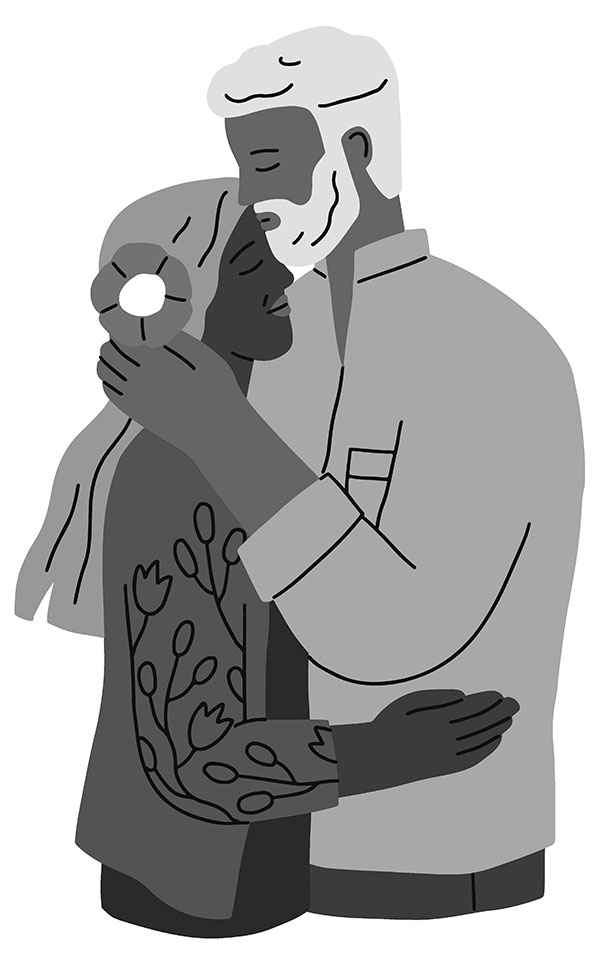
“Destiny Points” Aspects
There are two primary aspects we look at when we consider “destiny” points in a synastry chart. Not every soul mate relationship has these aspects, so it’s more of an observation and less of an astrological law.
The South Node is considered to be our past lives, our karma, and our lessons.
The North Node in astrology is considered our destiny point in the future - our fate, our purpose.
Any aspects that align with these two spots in the sky could indicate a future with a person (North Node) or a past life with a person (South Node).
For example, if you meet someone and feel an instant connection as if you’ve already known them your entire life, this is likely a past life connection re-emerging in this current incarnation. You two may have a compatible aspect of conjunction, trine, or sextile between Venus and the South Node if you had a good love in a past life and a good potential for love in this life as well.
If there’s an incompatible aspect like an opposition or square between Venus and the South Node on your synastry chart, that could indicate unresolved lessons and a karmic relationship between the two of you that need to be transmuted in this lifetime. Sometimes we feel so magnetically drawn to someone, and no matter how much we want it, it doesn’t work out. This is often because of unresolved past life karma between the two of you and would likely show up as an incompatible South Node aspect on the synastry chart. In this case, resolving those issues with that person in this lifetime is more so your destiny than actually being with them - but anything is possible.
The North Node is more self-explanatory because it insinuates the future of your current lifetime. So, a compatible aspect between the North Node and Venus on the synastry chart would indicate a romantic future for the two of you. Whereas an incompatible aspect between the North Node and Venus would still indicate a romantic future between the two of you, but a far more turbulent one. Aspects in our natal birth charts and synastry charts do relate to karma, in the way that easy aspects reflect the lessons we’ve learned successfully in past lives. The difficult aspects reflect the lessons we still have left to learn in this lifetime.
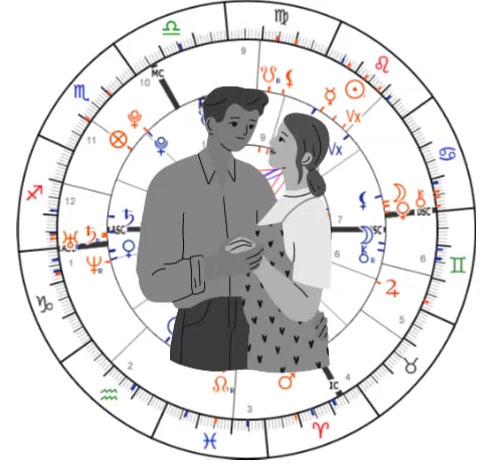
Conclusion
Overall, when using synastry charts to determine relationship compatibility and birth chart compatibility, use the chart as a tool to better understand your situation. Let the synastry chart highlight the positives and negatives in your relationships, so that you can know what areas in each relationship require your attention for optimal compatibility. As long as incompatible aspects are supported by complementary compatible aspects, then two people will have a greater chance of working through any issues and achieving happiness together. All problems are opportunities for growth in relationships, whether it’s best for you to grow together or to grow apart.
If you are interested and want to know more, synastry readings are available on Psychic Source. To see some examples of how aspects can influence a relationship, watch the video below.
Akasha is a clairsentient advisor on Psychic Source, as well as a Certified Spiritual Life Coach. Her intention is to give you the tools and knowledge needed to empower yourself on your spiritual and human journey, to connect with your own inner wisdom, and heal your life path. You each are truly sacred, and she hopes to see you honor that in this lifetime - to not just know it, but to feel it, see it, and live by it.
Guide to Astrology
Our comprehensive Astrology Guide covers astrology basics, from what is astrology, to the signs of the zodiac, how the sun, moon, and planets impact your life, and much more.
